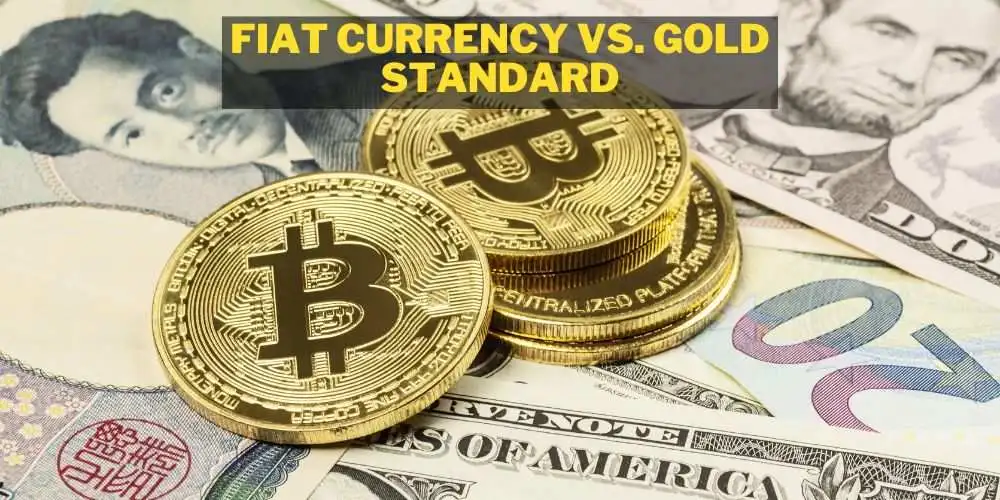In the realm of economics and finance, the debate between fiat currency and the gold standard remains a topic of enduring interest.
This fiat currency vs gold standard discussion not only touches upon historical economic practices but also impacts current financial stability and policy-making.
Through this article, we aim to embark on a comprehensive exploration of both economic systems, offering insights into their definitions, histories, and the pros and cons of each.
What Is Fiat Currency?

Fiat currency refers to money declared as legal tender by a government, yet it does not have physical value or backing by a physical commodity. Instead, its value comes from the trust and faith that individuals and businesses have in the government issuing it.
The history of fiat currency stretches back centuries, with China’s Tang Dynasty among the earliest adopters.
In modern times, fiat currency forms the backbone of the global economy, with all major countries utilizing it as their primary money system. Governments and central banks control fiat currency, adjusting supply to manage economic variables like inflation and unemployment.
However, this flexibility can be a double-edged sword. On one hand, it allows for more robust economic management. On the other, it can lead to inflation if overused.
What is the Gold Standard?
Contrastingly, the gold standard is a monetary system where a country’s currency has a value directly linked to gold. Under this standard, governments and individuals can exchange paper money for a specified amount of gold.

Historically, it provided a uniform form of exchange and stabilized global currencies. The stability associated with the gold standard is often cited as its primary benefit.
However, it also limited government flexibility in economic policy, particularly during recessions or crises, as the supply of money was tied directly to the amount of gold the country possessed.
Fiat Currency vs Gold Standard: An Honest Comparison
When comparing fiat currency and the gold standard, several key differences emerge. The basis of value, for one, is intrinsic with gold, while fiat currency relies on governmental backing.
This distinction profoundly influences inflation rates, economic policy flexibility, and international trade dynamics.
The shift from the gold standard to fiat currency globally was driven by the need for greater economic flexibility. The transition allowed governments to regulate their money supplies, adapting to economic changes more effectively. This era led to significant economic growth but also introduced new challenges, like managing inflation.
Advantages and Disadvantages at a Glance
Fiat currency allows for responsive economic policy but carries the risk of inflation if not properly managed.
The gold standard offers stability and limits governmental power but can restrict economic growth during downturns.
Historical instances, such as the Great Depression and the post-World War II economic boom, illustrate the practical effects of both systems.
Countries operating under the gold standard during the Great Depression struggled more significantly than those that abandoned it for fiat currency, demonstrating the flexibility and adaptive advantages of fiat currency in times of economic strain.
Current Trends and Future Considerations
Today, the conversation continues to evolve with the introduction of digital currencies and cryptocurrencies. These modern alternatives challenge traditional financial systems and may redefine the future of money.
Despite the shift towards digital currencies, the debate between fiat currency and the gold standard remains relevant.
It highlights fundamental economic principles like stability versus flexibility and government intervention versus market autonomy.
Frequently Asked Questions
Why did the world move away from the gold standard?
The world moved away from the gold standard to allow governments more control over their economies, enabling them to respond more effectively to financial crises and economic instability.
Can a country return to the gold standard today?
While theoretically possible, returning to the gold standard would pose significant challenges. It would require re-establishing gold reserves and could severely limit economic flexibility.
How do fiat currency and the gold standard affect individual savings and investments?
Under a gold standard, investments might be more stable but could see lower returns due to slower economic growth. Fiat currency provides opportunities for higher returns, albeit with higher inflation risk.
What role do central banks play under a fiat currency system versus the gold standard?
Central banks play a more active role under a fiat currency system, managing the money supply and interest rates. Under the gold standard, their role is more constrained, focusing on maintaining gold reserves.
Conclusion
The comparison between fiat currency and the gold standard unveils a fundamental economic dichotomy: the need for stability versus the desire for flexibility.
Each system has its advantages and disadvantages, shaped by historical contexts and current economic realities.
As we navigate the future of money, understanding the principles behind both systems is crucial. It informs not only economic policy but also individual financial decisions.
Regardless of the direction global economies take, the debate between fiat currency and the gold standard will remain a cornerstone of economic discourse.


 Tags:
Tags:










